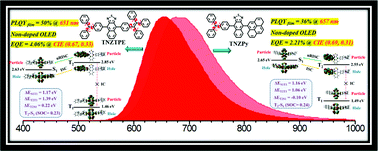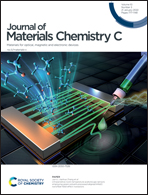Precise modulation of the triplet state distribution for high-efficiency non-doped standard saturated red OLEDs†
Abstract
“Hot exciton (HE)” channels highlight the reverse intersystem crossing (RISC) from high-lying triplet to singlet states and play an important role in developing highly efficient organic light-emitting diode (OLED) emitters. Compared with the upper RISC (uRISC) process that occurs on Tm → Sn (m ≥ 3, n ≥ 1), the triplet exciton conversion channel feature T2 → S1 should be theoretically more beneficial for improving the internal quantum efficiency (IQE) because the internal conversion (IC) rate (Tm → Tm−1, m ≥ 3) of the high-lying triplet exciton is faster than the uRISC rate (Tm → Sn, m ≥ 3, n ≥ 1). Therefore, the fine modulation of the excited-state properties of the T2 and S1 platforms, such as the energy levels and spin–orbit coupling (SOC), is meaningful for accelerating the uRISC (T2 → S1). Our previous work revealed that “baffle effect” and “plug-in effect” of triplet excitons are observed for naphtho[2,3-c]-[1,2,5]thiadiazole-based derivates. On the one hand, the “baffle effect” of the large energy gap between T2 and T1 is responsible for weakening the IC rate of the triplet exciton that arises via T2 → T1, on the other hand, the “plug-in effect” accurately modulates the T2 energy level via suitable molecular engineering. To further explore the influence of the T2 properties on the uRISC (T2 → S1), two deep red emitters (TNZPy and TNZTPE) with aggregation-induced emission (AIE) were firstly compared, not only to discuss the influence of the steric effects of the substituent group on the fluorescence efficiency at aggregation but also to investigate the influence of T2 level regulation on the uRISC. Fluorescence efficiency and IQE at aggregation can be simultaneously improved in the new TNZTPE emitter because the steric effect of the TPE unit suppresses the non-radiative channel based on effective T2 regulation, leading to the synthesis of a TNZTPE non-doped standard saturated red organic light-emitting diode (SSR-OLED) with an EQE of 4.06% with CIE coordinates of (0.67, 0.33).



 Please wait while we load your content...
Please wait while we load your content...